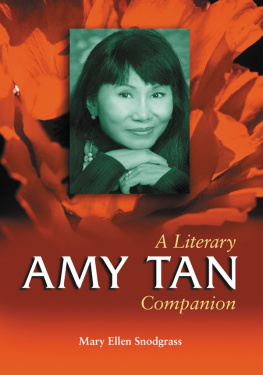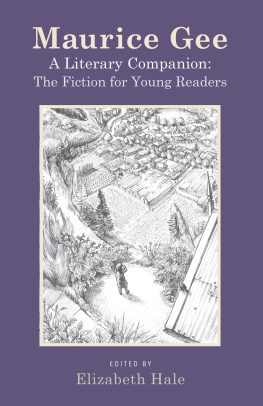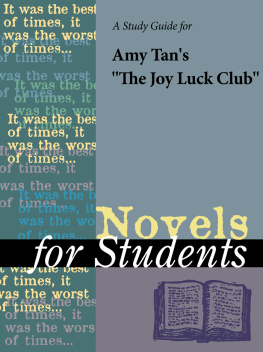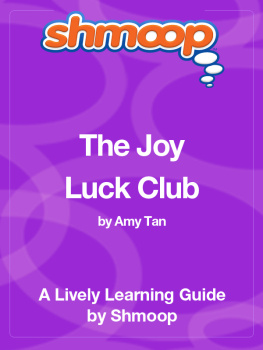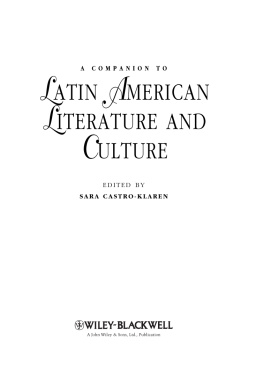
Contents
McFarland Literary Companions
By Mary Ellen Snodgrass
1. August Wilson (2004)
2. Barbara Kingsolver (2004)
3. Amy Tan (2004)
4. Walter Dean Myers (2006)
5. Kay Gibbons (2007)
6. Jamaica Kincaid (2008)
8. Peter Carey (2010)
10. Leslie Marmon Silko (2011)
LIBRARY OF CONGRESS CATALOGUING-IN-PUBLICATION DATA
Snodgrass, Mary Ellen.
Amy Tan : a literary companion / Mary Ellen Snodgrass.
p. cm. (McFarland literary companions ; 3)
Includes bibliographical references and index.
ISBN 0-7864-2013-8
1. Tan, AmyCriticism and interpretation. 2. Women and literatureUnited StatesHistory20th century. 3. Chinese American women in literature. 4. Chinese Americans in literature. I. Title. II. McFarland literary companion series ; 3.
PS3570.A48Z885 2004
813'.54dc22 2004014713
British Library cataloguing data are available
2004 Mary Ellen Snodgrass. All rights reserved
No part of this book may be reproduced or transmitted in any form or by any means, electronic or mechanical, including photocopying or recording, or by any information storage and retrieval system, without permission in writing from the publisher.
On the cover: Photograph of Amy Tan by Robert Soothorap; background 2004 Image Source
McFarland & Company, Inc., Publishers
Box 611, Jefferson, North Carolina 28640
www.mcfarlandpub.com
Acknowledgments
I owe thanks to Elise Capron at the Sandra Dijkstra Agency for the photographs of Amy Tan. Also, I acknowledge the advice and research assistance of the following people and institutions:
Avis Gachet, Book Buyer
Wonderland Books
Hickory, North Carolina
Hannah Owen, deputy director
Hickory Public Libraries
Hickory, North Carolina
Wanda Rozzelle and Amy Jew, reference librarians
Catawba County Library
Newton, North Carolina
Mark Schumacher, reference librarian
Jackson Library, UNC-G
Greensboro, North Carolina
The oppressed without hope are mysteriously quiet.
When the conception of change is beyond the limits of the possible,
there are no words to articulate discontent
so it is sometimes held not to exist.
But the fact that we could not hear does not prove that no pain existed.
Sheila Rowbotham
Womens Conscious, Mans World, 1973
You are beauty, and love is beauty and we are beauty.
We are divine, unchanged by time.
Amy Tan
The Bonesetters Daughter, 2001
Preface
For readers seeking a greater knowledge or understanding of Amy Tans contributions to feminist, American, and Amerasian literature, Amy Tan: A Literary Companion offers an introduction and overview. It equips the reader, feminist, historian, student, researcher, teacher, reviewer, and librarian with analysis of characters, plots, allusions, literary motifs, and classic themes from the works of one of Americas most lauded writers. The text opens with an annotated chronology of the authors life, Chinese heritage, works, and awards, followed by a family tree of the Tans. The 97 A-to-Z entries combine analysis from reviewers and critics along with generous citations from primary and secondary sources. Each entry concludes with a selected bibliography on such subjects as yin and yang, suicide, China, the historical milieu, autobiography, men, dismemberment, superstition, humor, and wisdom. Charts elucidate the convoluted genealogies of the Bonesetter Gu, Hsu, Jong, Kwong, Louie, St. Clair, Woo, Yee, and Young clans. In addition to clearing up confusion about Chinese names, these family trees account for connections between kinship lines, as with the link between the Youngs and the family of Dr. Gu, evidence that Winnie Louie and Helen Kwong are not related by blood or marriage, and the recovered sisterhood that joins Jack Yees two daughters with the prestigious Bishops of Hawaii. Generous cross references point to divergent strands of thought and guide the reader into peripheral territory, e.g., from violence to the Taiping Rebellion of 1864, abortion to spousal abuse, journeys to diaspora and reunions, patriarchy to disillusion and polygyny, and storytelling to talk-story, the female outlet for repressed memory and an antidote to the patriarchal silencing of women.
Back matter is designed to aid the student, reviewer, and researcher. Appendix A orients the beginner with a time line of historical events in China and during World War II and their intertextual importance to crises in the lives of fictional characters, for example, the approach of Communists to Shanghai and Wen Fus rape at gunpoint of his ex-wife. The entries contain abbreviated reference and page numbers of the works from which each event derives.
A second appendix compiles a glossary of foreign terms and idioms, such as multiple meanings of chang and mathematical descriptions of li and yuan, along with parts of speech, translation, and the appearance of the terms in Tans published works.
A third appendix provides forty-five topics for group or individual projects, composition, analysis, background material, enactment, and theme development, notably, cross-cultural mythology, motifs of matriarchy and marital discord, character attitudes toward materialism and spirituality, the authors choice of narrative modes, and the use of medical terms as character motivation.
Back matter concludes with an exhaustive chronological listing of primary sources and reprints followed by a general bibliography. Many entries derive from journal and periodical articles and reviews of Tans essays, novels, short fiction, and memoirs in the newspapers of major cities in the United States, Great Britain, Canada, China, and Australia. Secondary sources, particularly those by experienced reviewers, are useful for the study of works that have yet to be analyzed thoroughly in academic journals.
A comprehensive index directs users of the literary companion to major and minor characters, peoples, diseases, belief systems, deities, movements, events, eras, historical figures, place names, landmarks, traditional rituals and holidays, published works, sources, authors, and issues, e.g., Precious Auntie, Lao Lu and Buncake, Hakka, multiple sclerosis and Alzheimers disease, Taoism, Amitaba and Buddha, God Worshippers, Boxer Rebellion and Sino-Japanese War, Sung dynasty and Ching dynasty, Chiang Kai-shek and Claire Chennault, Kweilin, Chinatown, herbalism and Chinese New Year, The Color Purple and Fish Cheeks, calligraphy, Maxine Hong Kingston and Michael Dorris, and foot-binding, bride price, and matchmaking.
Introduction
Amy Tans writings are a model of the writers truism that the best subject lies close to home. Her domestic scenarios have the ring of authenticity, in part because she draws material from anecdotes and events that impact her own family. From closeness with her mother, Daisy Tan, the author absorbed a subjective appreciation of Chinese traditions, rituals, and history. Without apology, the author mined from talk-story a lifetime of oddments and topical strands to flesh out the attack of Manchu mercenaries on a Christian enclave, the terror of a refugee fleeing Japanese invaders, a despairing concubines death from deliberate opium consumption, an inkmakers loss from fire at a Peking shop, and an industrial magnates face-off against occupation forces. Flashes of realism leap from the pages as a teenager salts her diary with cruel taunts to her mother, a banner collapses on the elaborate funeral banquet honoring a Chinese matriarch, an apartment dweller eavesdrops on the intimate conversations of neighbors, a rebel child humiliates her parents by botching a piano recital, first-generation Chinese-American daughters distance themselves from their partially assimilated Chinese mothers, and a concubine lops off her hair as a gesture of defiance to patriarchy.
Next page
